
BY JUDY CARMACK BROSS
I’ve had a friend who describes it this way: the Badlands seem to have the capacity to expand one’s soul. –Randy Hatzenbuhler, President, The Theodore Roosevelt Medora Foundation

Teddy Roosevelt National Park.
Would you like to feel that you have a National Park all to yourself, with only black-tailed prairie dogs popping up to greet you, grazing bison, majestic elk seemingly posed on the green buttes above you, and herds of wild horses on your horizon?
Theodore Roosevelt National Park in Medora, North Dakota, about two hour’s drive from Bismarck, is the only National Park named for an individual, and it is hard to imagine a more “bully” honoree. Searching for what he called “the strenuous life,” our 26th President, the youngest ever elected, first came to the Dakota Territory in November of 1883 to hunt bison and see the American frontier.
In 1894 he returned, seeking escape from the grief of losing on Valentine’s Day both his young wife, Alice Lee, following childbirth and his beloved mother, Mittie, who died of typhoid fever. He left his newborn daughter, who would become the one-of-a-kind Alice Roosevelt Longworth, at home with his sister and headed to Dakota Territory.
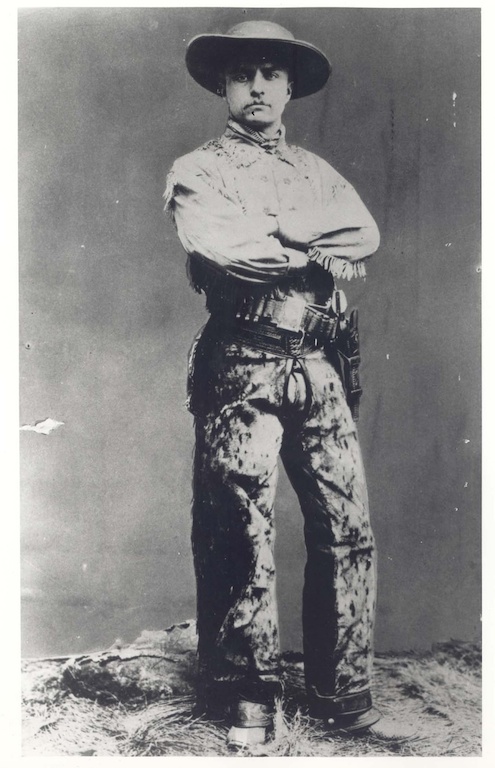
A young Roosevelt.
Throughout his life, he said it was the place he loved most of all.
Hatzenbuhler tells it this way: “The landscape has almost a spiritual quality to it, and it seems to do something when people see it. History tells us that Theodore Roosevelt was greatly impacted by his time in the Badlands. It was a place of healing and building his body, mind, and spirit.”
Located in the western part of North Dakota, the area is also called the Little Missouri Badlands, for the placid river that meanders through it. The term “badlands” refers to spaces where erosion has created a varied landscape, defined by buttes, gullies, and some vegetation.
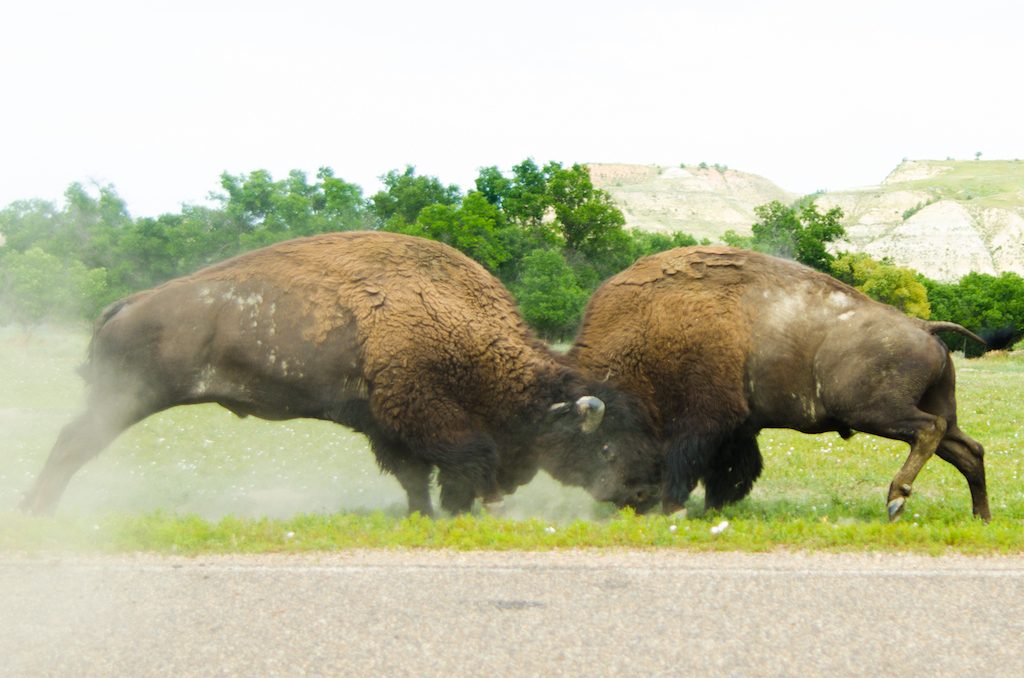
Bisons dueling in TR National Park.
In his lifetime, Theodore Roosevelt conserved an estimated 230 million acres of land by designating areas as national parks, forests, bird preserves, and wildlife preserves, drawing his inspiration from early days in the Badlands.
The park is open everyday of the year, although most people visit during the summer months. It averages 500,000 visitors a year, very low for a National Park. Peace is the park’s password.
Unlike many national parks during the summer months, there are no long lines to enter, rangers have time to recommend experiences, and junior rangers are encouraged to pick up the rare trash found along the way. At the Visitor’s Center at the park entrance, rangers offer up a variety of hikes, including one to see a petrified forest. Others bear names like Painted Canyon Nature Trail, Oxbow Overlook, and Caprock Coulee. A 36-mile scenic route is a good way to begin exploration.
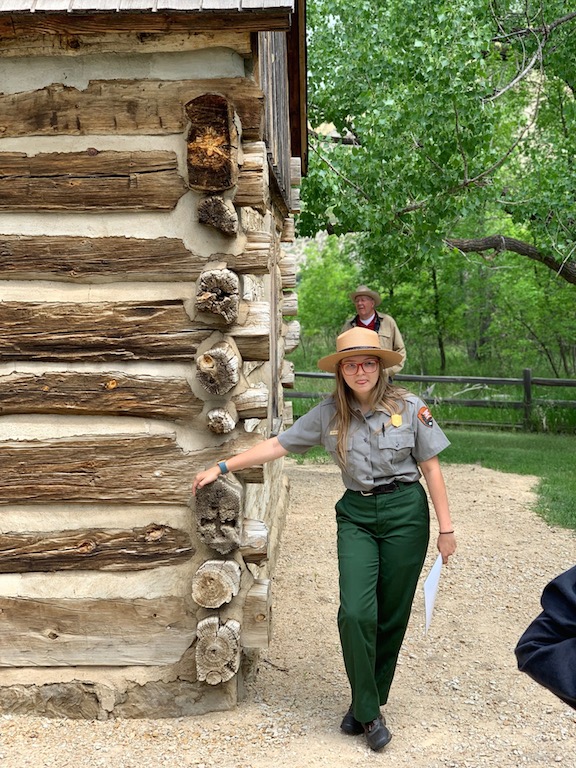
Ranger at Maltese Cross Cabin where TR first stayed in the area.
Town leaders continue to preserve the Badlands traditions and the history of the West. Harold Schafer, a man who loved Medora as much as TR himself, restored what had become almost a ghost cow town, beginning in the 1960s. The North Dakota businessman who made a fortune with Gold Seal Glass Wax and Mister Bubble bubble bath, recaptured Medora’s Western charm and appeal.
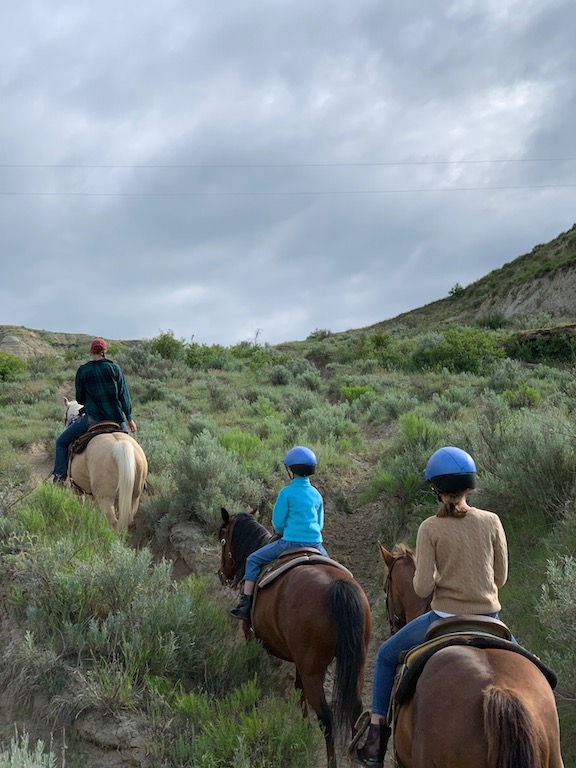
Horseback riding.
Whether you choose trail rides on beautiful and disciplined horses; eating steak cooked on a pitchfork; learning about Roosevelt and his friendship with the dashing French Aristocrat, the Marquis de Mores, who dreamed of becoming a cattle baron and his glamorous New York wife, Medora, a silk stocking turned sharp shooter and sidesaddle horsewoman; or playing golf at the Bully Pulpit Golf Course, there are adventures to be found in Medora.
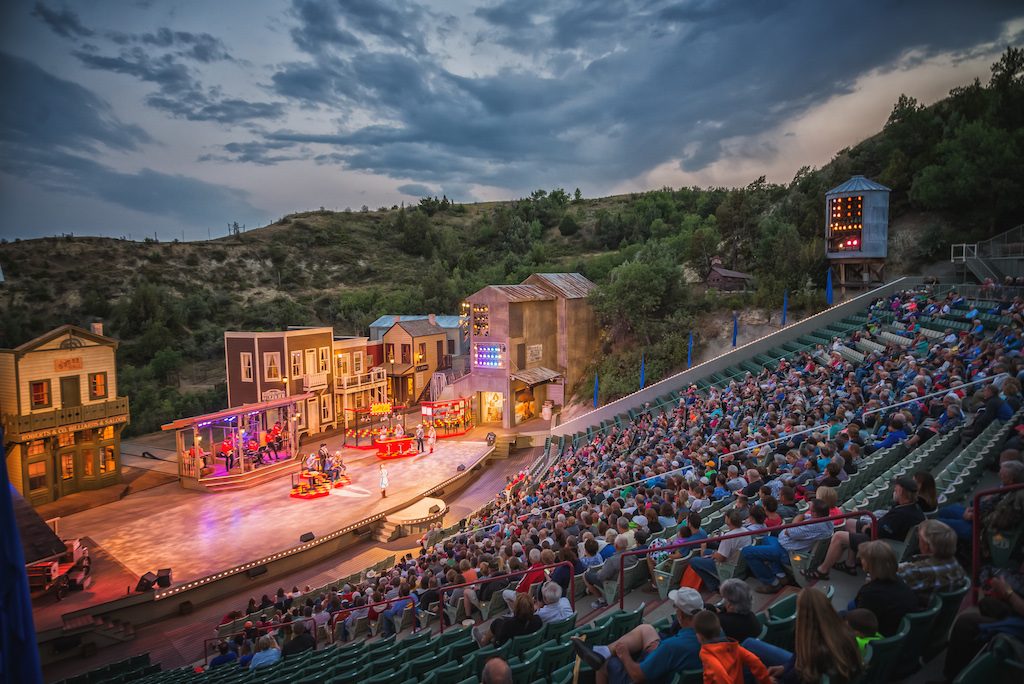
Medora the Musical and its stunning setting. Photo by J. Alan Paul.
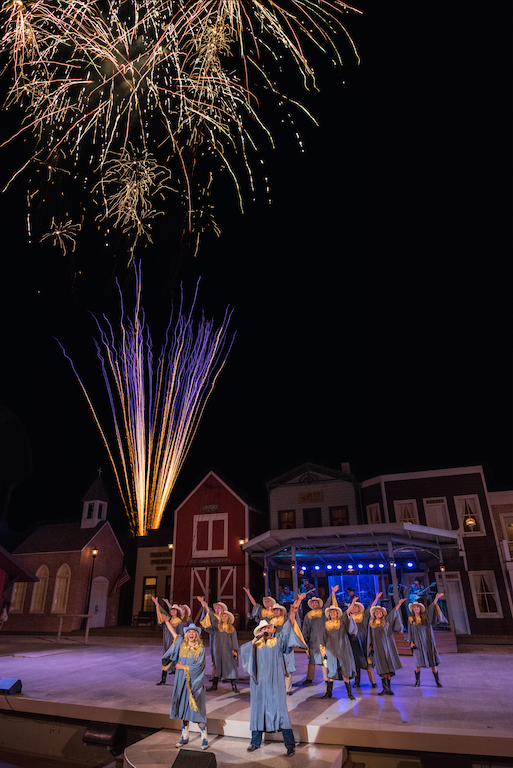
A Medora Musical gospel number, complete with fireworks.
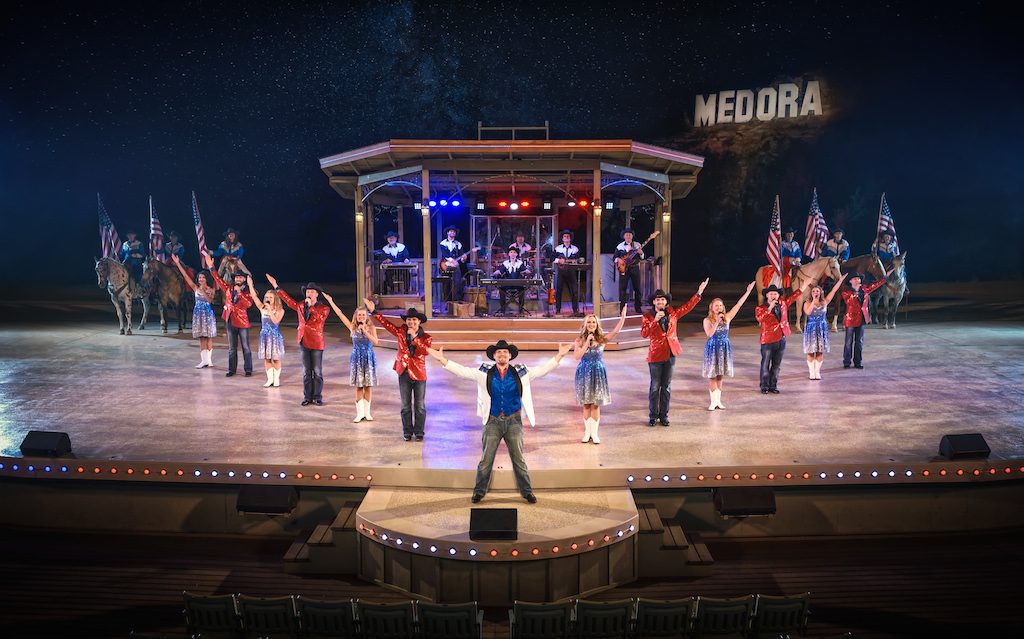
A Musical showstopper. Photo by J. Alan Paul.
Talented young entertainers from across the country perform in a musical extravaganza nightly called The Medora Musical, and hotels, such as the Rough Rider, where Roosevelt once stayed and now offers comfortable rooms, a wonderful dining room, and a library of books on the town hero are both Medora musts.
Sometimes the simplest thing—like watching boy scouts lower the American flag at the end of the day—becomes the most unforgettable.
Although there is a Teddy Roosevelt national monument on the island in the Potomac in Washington, DC, and he is commemorated on Mount Rushmore about four and a half hours away, there is no Presidential Library that bears his name. The Theodore Roosevelt Medora Foundation plans to change that.
Hatzenbuhler told us, “The Library project is at the ‘starting line,’ but it has a great tailwind with over $100 million already committed. The design and a thousand other details will be worked out in the coming 6 to 24 months. My responsibility will to raise the additional $100 million that we believe the project will require.
They are now just entering the public phase of the campaign, after receiving, thus far, about $52 million in private donations. The state of North Dakota has also committed $50 million to a sustaining endowment for the facility.
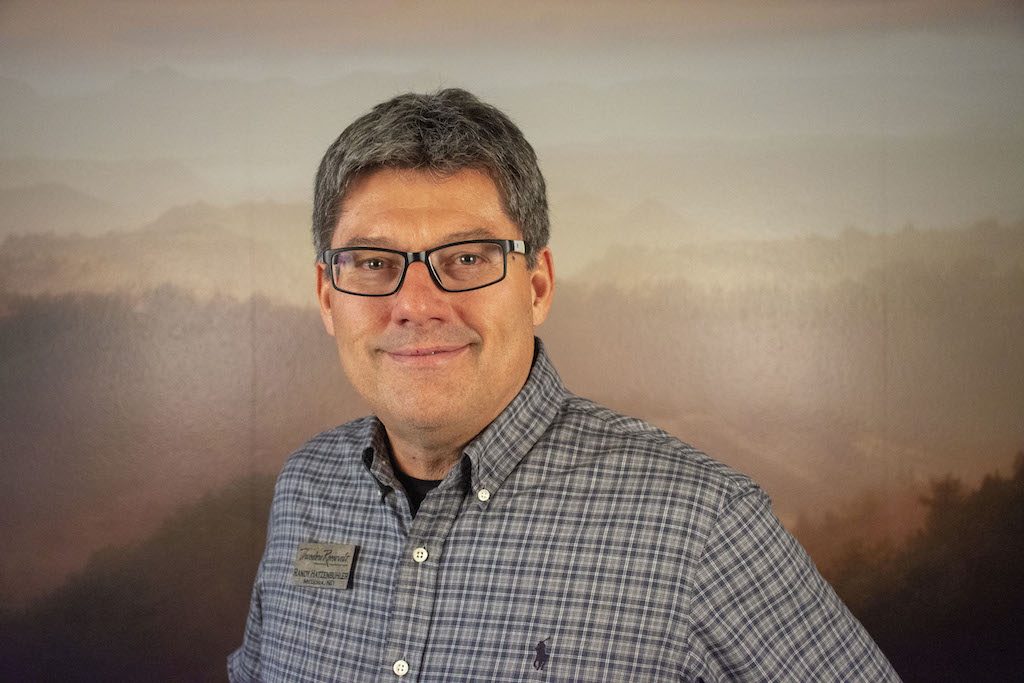
Randy Hatzenbuhler.
Hatzenbuhler told us more about the town: “People love surprises. In so many ways, Medora surprises them. It surprises them with the immense beauty of the landscape, it surprises them with the large scale theater, and production of the Medora musical. It surprises them with the rich history of Theodore Roosevelt, the Marquis de Mores, and the story of Medora herself. It absolutely surprises people that a community of only 112 people is the gateway to a spectacularly beautiful national park and home to a show that has played to over 4,000,000 people.”

Marquis and Medora von Hoffman.

Joe Wiegand as TR.
One of our nicest people you encounter is a former Chicagoan Joe Wiegand, now a Teddy Roosevelt “repriser” who suspends your disbelief with his performance, never stumped by any questions about his character’s life. He began a recent performance by telling the origin of the teddy bear, presenting one dressed as the President to a young family. In 1902 Roosevelt had refused to kill a bear that he felt other hunters had treated in an unsportsmanlike way. Some of the cutest teddy bears are to be found in the several gift shops in Medora.
On July 13 Wiegand will be sharing Roosevelt stories in Campton Hills, in the Fox River Valley, near St. Charles at the dedication of the restored 1906 Dairy Barn at Garfield Farm Museum at 5 pm.

“Teddy” with Medora Geary, descendent of Medora’s Medora, the wife of the Marquis de Mores.
We delighted in hearing Wiegand’s Chicago connection following the show: “My mom and dad met at Chicago’s Theodore Roosevelt High School in the late 1950s, and I grew up with two older brothers in Elmhurst, Illinois. In 1971 my father switched from being a heating and air contractor to being a stand-up comedian known as Jimmy Whig and later Jim Wiggins. He played Mr. Kelly’s and Earl’s of Old Town and helped found the Comedy Womb before we moved to Hollywood, where dad wrote for George Carlin, David Letterman, and Chuck Barris.”
He continued, “I returned to Illinois, graduating from Palatine High School. Many years later, the Edmund Morris book The Rise of Theaodore Roosevelt changed my life, and I began bringing the Rough Rider, conservation president to life for audiences throughout the Chicagoland region. I’ve now performed in all fifty states, at the White House, and overseas. It’s an honor and a pleasure to bring to life the man of whom his daughter Alice once said, ‘Father wanted to be the bride at every wedding, the corpse at every funeral, and the baby at every Christening.’ ”
Hatzenbuhler summed up the feel of Medora, which he describes as an intersection of history, education, and entertainment: “We meet people from all over the country and world in Medora, North Dakota. Some locals are bothered by the statement we hear so often: ‘North Dakota is my 50th state that I have visited.’ I don’t mind that quote at all because it is almost always followed by “We will be back; if we had known it was this wonderful, we would have come along time ago.’ We have always believed that if the visitor finds Medora to be the cleanest, friendliest, and safest place a traveler experiences, then we will have done our job. It is our best advertising.”
He invites readers to call him at 701-872-6633 for more information on the Theodore Roosevelt Presidential Library.
For a full listing of Medora events, visit medora.com. To learn more about Joe Wiegand’s Teddy Roosevelt reprise July 13, visit garfieldfarms.org.







